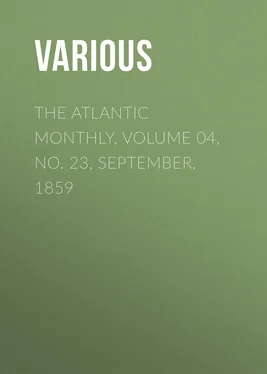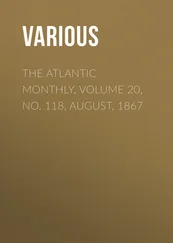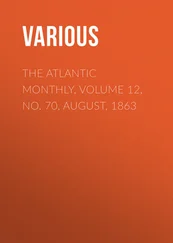Various - The Atlantic Monthly, Volume 04, No. 23, September, 1859
Здесь есть возможность читать онлайн «Various - The Atlantic Monthly, Volume 04, No. 23, September, 1859» — ознакомительный отрывок электронной книги совершенно бесплатно, а после прочтения отрывка купить полную версию. В некоторых случаях можно слушать аудио, скачать через торрент в формате fb2 и присутствует краткое содержание. Жанр: foreign_antique, periodic, foreign_edu, на английском языке. Описание произведения, (предисловие) а так же отзывы посетителей доступны на портале библиотеки ЛибКат.
- Название:The Atlantic Monthly, Volume 04, No. 23, September, 1859
- Автор:
- Жанр:
- Год:неизвестен
- ISBN:нет данных
- Рейтинг книги:4 / 5. Голосов: 1
-
Избранное:Добавить в избранное
- Отзывы:
-
Ваша оценка:
- 80
- 1
- 2
- 3
- 4
- 5
The Atlantic Monthly, Volume 04, No. 23, September, 1859: краткое содержание, описание и аннотация
Предлагаем к чтению аннотацию, описание, краткое содержание или предисловие (зависит от того, что написал сам автор книги «The Atlantic Monthly, Volume 04, No. 23, September, 1859»). Если вы не нашли необходимую информацию о книге — напишите в комментариях, мы постараемся отыскать её.
The Atlantic Monthly, Volume 04, No. 23, September, 1859 — читать онлайн ознакомительный отрывок
Ниже представлен текст книги, разбитый по страницам. Система сохранения места последней прочитанной страницы, позволяет с удобством читать онлайн бесплатно книгу «The Atlantic Monthly, Volume 04, No. 23, September, 1859», без необходимости каждый раз заново искать на чём Вы остановились. Поставьте закладку, и сможете в любой момент перейти на страницу, на которой закончили чтение.
Интервал:
Закладка:
Various
The Atlantic Monthly, Volume 04, No. 23, September, 1859 / A Magazine of Literature, Art, and Politics
The Life and Works of Ary Scheffer
No painter of this age has made so deep an impression on the popular mind of America as Ary Scheffer. Few, if any other contemporary artists are domesticated at our firesides, and known and loved in our remotest villages and towns. Only a small number, indeed, of his original works have been exhibited here,—yet engravings from them are not only familiar to every person of acknowledged taste and culture, but are dear to the hearts of many who scarcely know the artist's name. Young maidens delight in their tender pathos, and the suffering heart is consoled and elevated by their pure and lofty religious aspiration. An effect so great must have an adequate and peculiar cause; and we shall not have far to seek for it, but shall find it in the aim and character of the artist. Scheffer has two prominent qualities, by which he has won his place in the popular estimation. The first is his sentiment. His works are full of simple, tender pathos. His pictures always tell their story, first to the eye, next to the heart and soul of the beholder. His admirable knowledge of composition is always subordinate to expression. His meaning is not merely historical or poetical, but is true to life and every-day experience. "Mignon regrettant sa Patrie" is felt and appreciated by those who have never sung,
"Kennst du das Land wo die Citronen blühen,"—
and "Faust" and "Margaret" tell their story to all who have felt life's struggles and temptations, whether they have read them in Goethe's version or not. Added to this power of pathos and sentiment is the deep religious feeling which pervades every work of his pencil, whatever be its outward form. His religion is of no dogma or sect, but the inflowing of a life which makes all things holy and full of infinite meaning. Whether he paint the legends of the Catholic Church, as in "St. Augustine" and "St. Monica," or illustrate the life-poem of the Protestant Goethe, or tell a simple story of childhood, the same feelings are kindled, in our heart's faith in God, love to man, the sure hope of immortality. It is this genuine and earnest religion of humanity which has made his works familiar to every lover of Art and sentiment, and given us a feeling of personal love and reverence for the made artist.
It is now nearly a year since his labors on earth terminated, and yet no adequate account of his life and labors has appeared. It is very difficult to satisfy the craving desire to know more of the personal life and character of him who has been a household friend so long. Yet it is rather the privilege of succeeding generations, than of contemporaries, to draw aside the veil from the sanctuary, and to behold the works of a man in his greatest art,—the art of life. But the cold waters of the Atlantic, like the river of Death, make the person of a European artist sacred to us; and it is hard for us to realize that those whom we have surrounded with a halo of classic reverence were partakers of the daily jar and turmoil of our busy age,—that the good physician who tended our sick children so faithfully had lived in familiar intercourse with Goethe, and might have listened to the first performance of those symphonies of Beethoven which seem to us as eternal as the mountains. Losing the effluence of his personal presence, which his neighbors and countrymen enjoyed, we demand the privilege of posterity to hear and tell all that can be told of him. We can wait fifty years more for a biography of Allston, because something of his gracious presence yet lingers among us; but we can touch Scheffer only with the burin or the pen. So we shall throw in our mite to fill up this chasm. A few gleanings from current French literature, a few anecdotes familiarly told of the great artist, and the vivid recollection of one short interview are all the aids we can summon to enable our readers to call up in their own minds a living image which will answer to the name that has so long been familiar to our lips and dear to our hearts.
Ary Scheffer was born about the year 1795, in the town of Dordrecht, in Holland; but, as at that period Holland belonged to the French Empire, the child was entitled by birth to those privileges of a French citizen which opened to him important advantages in his artistic career. French by this accident of birth, and still more so by his education and long residence at Paris, he yet always retained traces of his Teutonic origin in the form of his head, in his general appearance, and in his earnest and religious character. He always cherished a warm affection for his native land.
Many distinguished artists have been the sons of painters or designers of superior note. Raffaello, Albert Dürer, Alonzo Cano, Vandyck, Luca Giordano are familiar instances. It seems as if the accumulation of two generations of talent were necessary to produce the fine flower of genius. The father of Ary Scheffer was an artist of considerable ability, and promised to become an eminent painter, when he was cut off by an early death. He left a widow, many unfinished pictures, and three sons, yet very young. The character of the mother we infer only from her influence on her son, from the devoted affection he bore to her, and from the wisdom with which she guided his early education; but these show her to have been a true woman,—brave, loving, and always loyal to the highest. The three sons all lived to middle age, and all became distinguished men. Ary, the eldest, very early gave unequivocal signs of his future destiny. His countrymen still remember a large picture painted by him at Amsterdam when only twelve years old, indicating extraordinary talent, even at that early age. His mother did not, however, overrate this boyish success, as stamping him a prodigy, but regarded it only as a motive for giving him a thorough artistic education. He went, accordingly, to Paris, and entered the atelier of Guérin, the teacher then most in vogue.
It was in the latter days of the Empire that Ary Scheffer commenced his studies,—a period of great stagnation in Art. The whole force of the popular mind had for many years been turned to politics and war; and if French Art had striven to emancipate itself from slavish dependence on the Greek, it still clung to the Roman models, which are far less inspiring. "The autocrat David, with his correct, but soulless compositions, was more absolute than his master, the Emperor." Only in the Saloon of 1819 did the Revolution, which had already affected every other department of thought and life, reach the ateliers . It commenced in that of Guérin. The very weakness of the master, who himself halted between two opinions, left the pupils in freedom to pursue their own course. Scheffer did not esteem this a fortunate circumstance for himself. His own nature was too strong and living to be crushed by a severe master or exact study, and he felt the want of that thorough early training which would have saved him much struggle in after life. He used to speak of Ingres as such a teacher as he would have chosen for himself. From the pupil of David, the admirer of Michel Angelo, the conservator of the sacred traditions of Art, the student might learn all the treasured wisdom of antiquity,—while the influences around him, and his own genius, would impel him towards prophesying the hope of the future. His favorite companions of the atelier at this time were Eugène Delacroix and Géricault. Delacroix ranks among the greatest living French artists; and if death early closed the brilliant career of Géricault, it has not yet shrouded his name in oblivion. The trio made their first appearance together in the Saloon of 1819. Géricault sent his "Wreck of the Medusa," Delacroix "The Barque of Dante," and Ary Scheffer "The Citizens of Calais." 1 1 This picture is now in the Louvre. It is a composition of great dramatic power. Mrs. Stowe gives a graphic description of the effect it produced upon her, in her "Sunny Memories of Sunny Lands."
Интервал:
Закладка:
Похожие книги на «The Atlantic Monthly, Volume 04, No. 23, September, 1859»
Представляем Вашему вниманию похожие книги на «The Atlantic Monthly, Volume 04, No. 23, September, 1859» списком для выбора. Мы отобрали схожую по названию и смыслу литературу в надежде предоставить читателям больше вариантов отыскать новые, интересные, ещё непрочитанные произведения.
Обсуждение, отзывы о книге «The Atlantic Monthly, Volume 04, No. 23, September, 1859» и просто собственные мнения читателей. Оставьте ваши комментарии, напишите, что Вы думаете о произведении, его смысле или главных героях. Укажите что конкретно понравилось, а что нет, и почему Вы так считаете.












